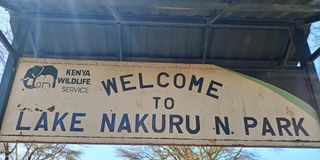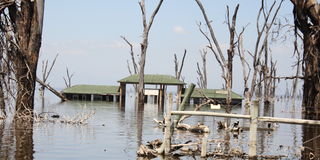Visirani vya Nyani: The birth of Lake Nakuru National Park

A sign post indicating entry into Lake Nakuru National Park.
Lake Nakuru National park, the main tourist attraction site in Nakuru County has remained part and parcel of the community in the region.
Encircled in an expansive landmass of about 188 square kilometres, Lake Nakuru national park is one of the three premium parks in the country, boasting of breath taking landscapes, expansive savannah grasslands, and the beautifully pink Lake Nakuru.
The history of the park however dates back to the colonial times when the southern part of the lake was declared a wildlife conservation area for the birds at Lake Nakuru in 1957.
The aim was to reduce pollution and conserve the birds’ natural habitat.

Zebras spotted in Lake Nakuru National park.
Being one of the most captivating wildlife destination in the county the park is a home to over 450 bird species giving its name as the bird watchers paradise.
The birds include the greater and lesser flamingos, African Fish Eagle, Slender-billed greenbul, Long-tailed widowbird, Rufous-throated wryneck, Montane white-eye, and many more
It also hosts the Rothschild giraffe and is a sanctuary to the endangered black and white rhino.
Other wild animals include lions, leopards, buffalo, zebra, and impala among others baboons
The area was declared a bird sanctuary in 1961 and placed under the management of the Kenya Royal National Parks.
In 1964, the conservation area was extended to cover the entire lake and the small strip surrounding it before it was officially gazetted as a national park in 1968, covering an area of approximately 60 square kilometres.
To reduce human-wildlife conflict, the 74 kilometre perimeter park borderline was then fenced with a chain wire link in 1976, before the park was named the home of the endangered Rothschild giraffe species.
Also Read: KWS to upgrade 78km of fence in Lake Nakuru National Park to reduce human-wildlife conflict
Later in 1984 the park was established as the first government protected rhino sanctuary to prevent further declining of the black and white rhino.
A solar powered electric fence was installed to reinforce the chainlink in 1986 before the park was designated a ramsar site in 1990 (a listed site or wetland of international importance for the management of migratory waterfowls).
Since then the park has undergone significant changes and developments that have played to improve its status.
One of the significant changes include the decreased size of the land due to the rise in water levels which significantly ate into the land size.

One of the gates to Lake Nakuru National Park that is submerged in water.
This, according to Mr Titus Mitau, the park in charge, has interrupted the habitats of some animals and pushed them elsewhere.
These include the baboons whose habitats he said were inhabited by predators, forcing them to move away extending to residential areas.
Over time, the park management has had to deal with some of the challenges that arose by the virtue of the park bordering the community land such as the human-wildlife conflict, poaching and destruction of park infrastructure.
However, the community around has also benefited through employment opportunities, subsidized entrance fees and the corporate social responsibilities.
“The park is the gem to the people of Nakuru which is the reason tourists come from far countries abroad to visit the county,” said Mr Joseph Muya – the director of the Lake Nakuru Lodge.
The park receives an average of 10,000 visitors per year to visit various sites including the camp sites, Makalia falls, and the baboon cliff, the lake Nakuru as well as wild animals.
While the locals pay Sh 1000 for a tour inside the park, foreign tourists have to cough at least Sh 9,000 as entrance fees.
